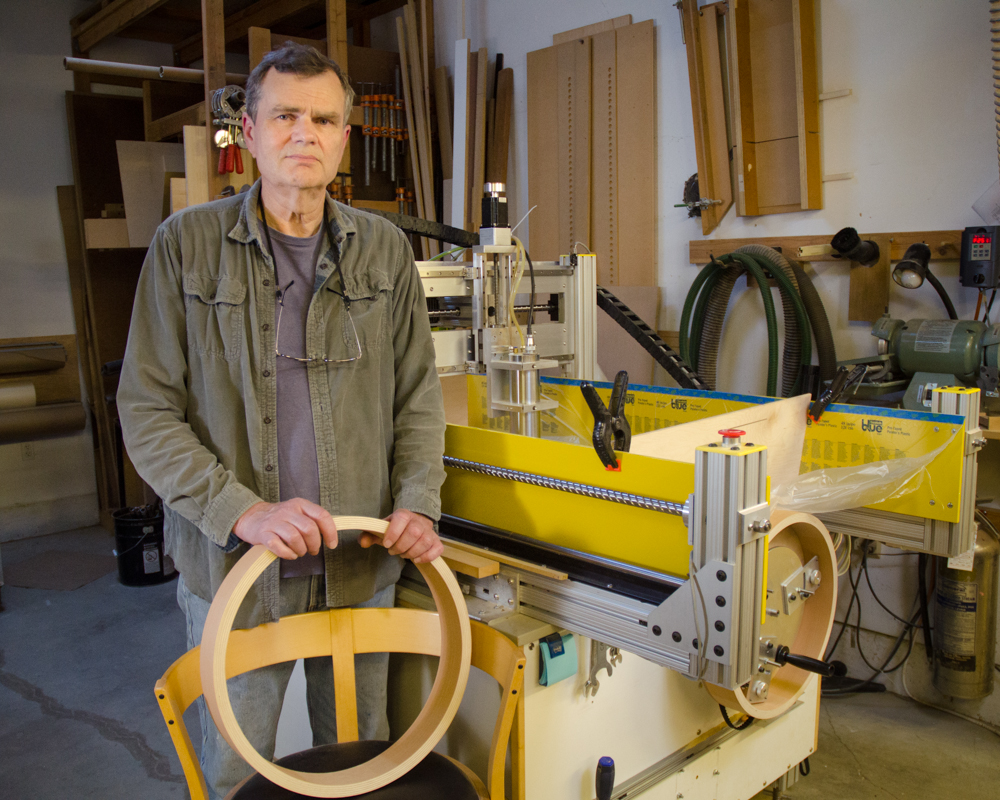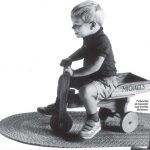We may receive a commission when you use our affiliate links. However, this does not impact our recommendations.
Meet the artists from the December 2017 issue
How five masterful makers integrate CNC and CAD technology into their woodworking.
In the December 2017 issue of Popular Woodworking magazine, the article, Digital Artistry gives the readers a peek at what five professional woodworkers are doing with digital tools in their shops. Each has an extensive traditional woodworking background and many years of experience before they added digital tools like CAD software and CNC machines to their workflow. All five of us are friends and meet regularly as a group to exchange ideas and techniques as we explore this new digital world.
For the print article, I thought it would be interesting for readers to hear each woodworker introduced themselves, say something about their backgrounds, their work and how they got started using digital tools. To do this, I sent out a survey to each member of the group with a series of questions.
With the space limitations in print publishing, only a few quotes from each questionnaire made it into the final article. With so much interesting information collected, I thought Popular Woodworking’s readers would like to hear more about each woodworker’s world. So, in this series of posts on Digital Artistry, I’ll share each woodworker’s survey answers with our online readers. To start off each post in the series, I’m including a short video interview with each artist.
This first post is about Curtis Erpelding and his work. Rather than answer the survey, Curtis took the process a step farther and revealed even more. The questionnaire became a jumping off point from which to write about his woodworking world, his history, his shop and how he’s integrated CAD and CNCs into his creative process and his work.
So, here is Curtis in his own words…
Curtis Erpelding
 My woodworking history
My woodworking history
I’ve been a self-employed furniture maker since 1977. My initial interest was in furniture design, not so much in woodworking per se. Over time, like most woodworkers, I found the nature of the material seductive and it actually became more feasible to market my work as “fine woodworking” rather than as “fine furniture design”. The distinction may seem trivial but it determined the course of my career to a great extent. People in general, find the nature of wood appealing. As a material, it’s warm, attractive, variable in figure and pattern and it’s loaded with positive associations – nature, trees, memories of fathers and grandfathers who had shops and tools. It was easier in many ways to connect with customers through the actual material than through the manipulation (design) of that material.
 As a result, my marketing focus moved away from products defined by design to products defined by material and craftsmanship. Much of the work I’ve done over the years has been one of a kind commissions. That’s not to say I gave up on the idea of a more design-focused approach. Early on in 1980, I received a grant from the National Endowment for the Arts to develop furniture prototypes designed for mass production. One of these designs was a stacking chair which I’ve produced in small production runs since the early 1980’s. Even these, however, were built with the “fine woodworking” market in mind, using furniture grade hardwood for bent laminations and leather upholstered seats.
As a result, my marketing focus moved away from products defined by design to products defined by material and craftsmanship. Much of the work I’ve done over the years has been one of a kind commissions. That’s not to say I gave up on the idea of a more design-focused approach. Early on in 1980, I received a grant from the National Endowment for the Arts to develop furniture prototypes designed for mass production. One of these designs was a stacking chair which I’ve produced in small production runs since the early 1980’s. Even these, however, were built with the “fine woodworking” market in mind, using furniture grade hardwood for bent laminations and leather upholstered seats.
 I work out of a 1200 square foot shop on my property. Originally it was a two car garage that I expanded and remodeled to create a finishing room, an assembly area and, on a second floor, an office and storage area. My equipment is modest both in scale and quality. Probably the most commercial machine I have is a 24-inch wide belt sander I bought used and runs on a 3-phase converter. The scale of the individual pieces I’ve made rarely been very large. I’ve been able to get by with machines that would be familiar in most hobbyists’ shops.
I work out of a 1200 square foot shop on my property. Originally it was a two car garage that I expanded and remodeled to create a finishing room, an assembly area and, on a second floor, an office and storage area. My equipment is modest both in scale and quality. Probably the most commercial machine I have is a 24-inch wide belt sander I bought used and runs on a 3-phase converter. The scale of the individual pieces I’ve made rarely been very large. I’ve been able to get by with machines that would be familiar in most hobbyists’ shops.
For a period of time in the late 1980’s, I had an ongoing contract to make small boxes out of solid wood with rabbeted lids that fit inside routed out bodies. I used a pin router with templates to cut the outside profile, the inside pockets and the offset for the lid rabbet. I’ve always been a “jig” person, willing to spend the extra time to create a special fixture to ensure that the fashioning of a part is accurate and repeatable. I was intrigued with the potential of the pin router to create all sorts of furniture parts and patterns but after the box contract ended the pin router, which I had borrowed, was returned and though I intended to, I never pursued buying one and exploring its possibilities.
My digital beginnings
 Jump forward about 15 years and a casual conversation with a woodworking friend lit a light bulb. I was telling him about my boxes and pin router experience and mentioned how I wanted to eventually to get a pin router. His reply was, “Why not get a CNC router?” By the early 2000’s it was a reasonable question. The price and scale of computer-controlled routers had fallen to the level where they were becoming affordable to the small shop.
Jump forward about 15 years and a casual conversation with a woodworking friend lit a light bulb. I was telling him about my boxes and pin router experience and mentioned how I wanted to eventually to get a pin router. His reply was, “Why not get a CNC router?” By the early 2000’s it was a reasonable question. The price and scale of computer-controlled routers had fallen to the level where they were becoming affordable to the small shop.
Plus there was an online community of people, including hardware, software, and electronic engineers, plus computer geeks who were building their own machines.  Being a general computer-phobe, the idea of getting into the world of CNC was daunting. But I had managed to overcome my fear of computers when I had seen a clear application to my own needs, teaching myself how to use wood processing programs and becoming reasonably proficient with Photoshop. Plus I had built several of the machines in my shop and the idea of building my own CNC router, though perhaps foolish, was at the same time irresistible.
Being a general computer-phobe, the idea of getting into the world of CNC was daunting. But I had managed to overcome my fear of computers when I had seen a clear application to my own needs, teaching myself how to use wood processing programs and becoming reasonably proficient with Photoshop. Plus I had built several of the machines in my shop and the idea of building my own CNC router, though perhaps foolish, was at the same time irresistible.
 I realized that the first step in this journey would be learning how to use CAD, so I spent about a year doing that before I even seriously started looking at CNC options. And in a way, the acquisition of CAD perhaps became even more important than actually employing a computer controlled router although the two, of course, are inextricably linked. Learning CAD wasn’t just a gateway into the CNC world, it changed the very way I designed. Having 3d visualization and rendering capability not only made designing faster and communicating ideas to customers easier, it also opened up possibilities that would have been inconceivable or at best foolhardy because of the complexities involved.
I realized that the first step in this journey would be learning how to use CAD, so I spent about a year doing that before I even seriously started looking at CNC options. And in a way, the acquisition of CAD perhaps became even more important than actually employing a computer controlled router although the two, of course, are inextricably linked. Learning CAD wasn’t just a gateway into the CNC world, it changed the very way I designed. Having 3d visualization and rendering capability not only made designing faster and communicating ideas to customers easier, it also opened up possibilities that would have been inconceivable or at best foolhardy because of the complexities involved.
How I use a CNC
 Whenever a visitor to the shop asks me what I actually use the CNC for I seem to be at a loss for words. It’s like a civilian seeing a chisel on your bench and asking “What’s that for?” Well, you chop and pare with it, but within that mundane explanation, there are probably thousands of variations on how the tool is used. Our use of tools becomes unconscious. When we need to do something, we grab the tool and do it and then move on to the next task.
Whenever a visitor to the shop asks me what I actually use the CNC for I seem to be at a loss for words. It’s like a civilian seeing a chisel on your bench and asking “What’s that for?” Well, you chop and pare with it, but within that mundane explanation, there are probably thousands of variations on how the tool is used. Our use of tools becomes unconscious. When we need to do something, we grab the tool and do it and then move on to the next task.  There are tool fetishists of course. Those who can expound at length on the best types of tool steels, the techniques of tempering, the angle of bevel grinding, the correct ergonomics of usage. And I’ve been guilty myself more than once of boring a listener with a recitation of information way beyond the scope of the original question. In the end, however, the value of any tool in a commercial shop comes down to its utility. What is the tool good for?
There are tool fetishists of course. Those who can expound at length on the best types of tool steels, the techniques of tempering, the angle of bevel grinding, the correct ergonomics of usage. And I’ve been guilty myself more than once of boring a listener with a recitation of information way beyond the scope of the original question. In the end, however, the value of any tool in a commercial shop comes down to its utility. What is the tool good for?
What is a CNC good for? It’s fast, insanely precise, repeatable and, once you push the run button, automatic. You can stand amazed and watch it go through all its Cartesian moves, or you can wander off and apply yourself to another shop task while it’s running, including having a cup of coffee and browsing the internet. I’ve used my CNC to cut templates, carve furniture legs, create bending forms for compound curved laminations, engrave brass, drill holes for adjustable shelves, cut polygonal miters that fit perfectly without trial and error test runs, cut grooves and parts for intricate inlay, create a spiral ramp in a router base to facilitate ejecting chips and dust, cut aluminum, cut mortises and tenons in carcass construction that can be tuned in the software to slide together with the perfect amount of friction for the glue used — if the joints are symmetrical from the center line it’s possible to assemble the parts upside down or reversed–the precision requires fool proof orientation marks! The list could go on and on and I’m sure I’m not remembering even half of the uses I’ve found. The uses for a CNC are obvious and not so obvious. The challenge is to not to become too complacent with the uses I’ve already found but to keep the question in mind, “What else is this tool capable of that I haven’t even thought of yet?”
 My CNC
My CNC
The router I eventually ended up building — at least in its current iteration, has a cutting area of 24″ x 52″ with approximately 8″ of “Z” (up and down) travel). This is on the small side but it fits my shop space, my work needs and the small theme of most of the machines in my shop which include 10″ table saws, a 2HP shaper, a 14″ bandsaw and a 6″/12″ planer-jointer. This scale has worked well for me over the years given the nature of my work. Most woodworkers lust after 12″ or wider jointers but it’s rare that I need to surface a board beyond the 6″ capacity of my jointer. Although, I once used my CNC router to surface, flatten and thickness a 3″ thick x 20″x72″ live edge slab–try pushing that over a jointer, even if it’s wide enough! I think by building my own tool I understand how it works better than if I had purchased one. This includes the mechanical, electrical and software aspects. There’s no denying that a learning curve is involved when you plunge into the world of CNC. There’s a lot to learn and like many other skills, if you don’t put time into using what you learn, that is, actually creating programs and running the machine, it’s amazing how fast you forget. But it’s engaging as well, requiring far more cognitive skills than other machines do. The boring and dangerous part of most machine use–the tedious and fatiguing repetition–is mostly eliminated by the automatic nature of CNC. The fun part of designing and strategizing takes place in CAD and planning.
 Looking to the future
Looking to the future
I’m at a stage in my career where I can see CNC technology allowing me to return to my roots as a designer and maker of production furniture. I’m in the process of redesigning my stacking chair, changing completely not the look but the way it’s made. With the CNC I’m creating large bending forms and fixtures that will allow the making and machining of many multiple parts at once. The router will allow me to make joints that are much stronger and more aesthetically pleasing than I could have dreamed of before. And in a fraction of the time. Increased productivity usually boils down to less labor and faster results. This is what the CNC promises and delivers.
Curtis Erpelding
Additional Resources
- Curtis Erpelding’s website click here
- All posts on the featured Digital Artists, click here
- December 2017 Issue of Popular Woodworking click here
- Digital Woodworking on Instagram
- Personal Work on Instagram
- Digital Woodworking YouTube Channel
Here are some supplies and tools we find essential in our everyday work around the shop. We may receive a commission from sales referred by our links; however, we have carefully selected these products for their usefulness and quality.











I thought I’d share a bit of history here – Curtis wrote in to Pacific Woodworker (which later become Popular Woodworker, and then Popular Woodworking) in the September/October issue in 1981! I stumbled on his name while digging through our archives, and as a testament to his long history in woodworking and engagement with the editors of the magazine!